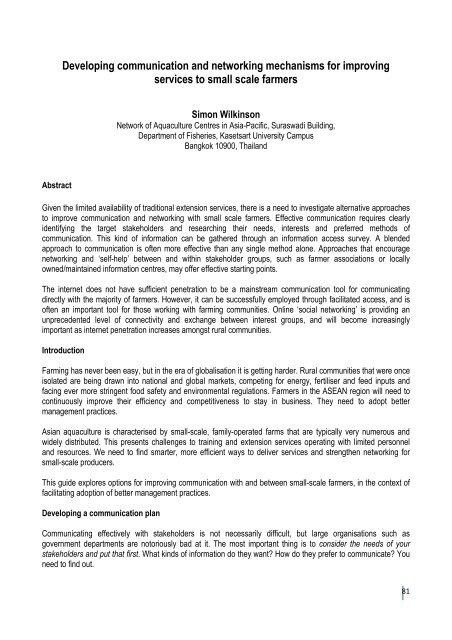Training of Trainers - Library - Network of Aquaculture Centres in ...
Training of Trainers - Library - Network of Aquaculture Centres in ...
Training of Trainers - Library - Network of Aquaculture Centres in ...
- No tags were found...
You also want an ePaper? Increase the reach of your titles
YUMPU automatically turns print PDFs into web optimized ePapers that Google loves.
Develop<strong>in</strong>g communication and network<strong>in</strong>g mechanisms for improv<strong>in</strong>gservices to small scale farmersSimon Wilk<strong>in</strong>son<strong>Network</strong> <strong>of</strong> <strong>Aquaculture</strong> <strong>Centres</strong> <strong>in</strong> Asia-Pacific, Suraswadi Build<strong>in</strong>g,Department <strong>of</strong> Fisheries, Kasetsart University CampusBangkok 10900, ThailandAbstractGiven the limited availability <strong>of</strong> traditional extension services, there is a need to <strong>in</strong>vestigate alternative approachesto improve communication and network<strong>in</strong>g with small scale farmers. Effective communication requires clearlyidentify<strong>in</strong>g the target stakeholders and research<strong>in</strong>g their needs, <strong>in</strong>terests and preferred methods <strong>of</strong>communication. This k<strong>in</strong>d <strong>of</strong> <strong>in</strong>formation can be gathered through an <strong>in</strong>formation access survey. A blendedapproach to communication is <strong>of</strong>ten more effective than any s<strong>in</strong>gle method alone. Approaches that encouragenetwork<strong>in</strong>g and ‘self-help’ between and with<strong>in</strong> stakeholder groups, such as farmer associations or locallyowned/ma<strong>in</strong>ta<strong>in</strong>ed <strong>in</strong>formation centres, may <strong>of</strong>fer effective start<strong>in</strong>g po<strong>in</strong>ts.The <strong>in</strong>ternet does not have sufficient penetration to be a ma<strong>in</strong>stream communication tool for communicat<strong>in</strong>gdirectly with the majority <strong>of</strong> farmers. However, it can be successfully employed through facilitated access, and is<strong>of</strong>ten an important tool for those work<strong>in</strong>g with farm<strong>in</strong>g communities. Onl<strong>in</strong>e ‘social network<strong>in</strong>g’ is provid<strong>in</strong>g anunprecedented level <strong>of</strong> connectivity and exchange between <strong>in</strong>terest groups, and will become <strong>in</strong>creas<strong>in</strong>glyimportant as <strong>in</strong>ternet penetration <strong>in</strong>creases amongst rural communities.IntroductionFarm<strong>in</strong>g has never been easy, but <strong>in</strong> the era <strong>of</strong> globalisation it is gett<strong>in</strong>g harder. Rural communities that were onceisolated are be<strong>in</strong>g drawn <strong>in</strong>to national and global markets, compet<strong>in</strong>g for energy, fertiliser and feed <strong>in</strong>puts andfac<strong>in</strong>g ever more str<strong>in</strong>gent food safety and environmental regulations. Farmers <strong>in</strong> the ASEAN region will need tocont<strong>in</strong>uously improve their efficiency and competitiveness to stay <strong>in</strong> bus<strong>in</strong>ess. They need to adopt bettermanagement practices.Asian aquaculture is characterised by small-scale, family-operated farms that are typically very numerous andwidely distributed. This presents challenges to tra<strong>in</strong><strong>in</strong>g and extension services operat<strong>in</strong>g with limited personneland resources. We need to f<strong>in</strong>d smarter, more efficient ways to deliver services and strengthen network<strong>in</strong>g forsmall-scale producers.This guide explores options for improv<strong>in</strong>g communication with and between small-scale farmers, <strong>in</strong> the context <strong>of</strong>facilitat<strong>in</strong>g adoption <strong>of</strong> better management practices.Develop<strong>in</strong>g a communication planCommunicat<strong>in</strong>g effectively with stakeholders is not necessarily difficult, but large organisations such asgovernment departments are notoriously bad at it. The most important th<strong>in</strong>g is to consider the needs <strong>of</strong> yourstakeholders and put that first. What k<strong>in</strong>ds <strong>of</strong> <strong>in</strong>formation do they want? How do they prefer to communicate? Youneed to f<strong>in</strong>d out.81
















